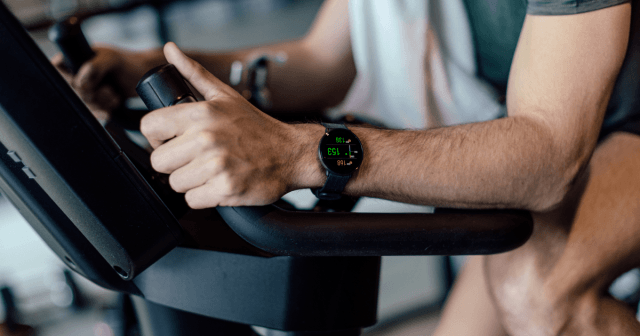We all know walking is good for our health. Getting away from your computer or phone screen, leaving the car at home, going for a leisurely stroll. Maybe taking the dog with you or using it as an opportunity to chat with your partner or friend. Ideally, immersing yourself in green spaces, fresh air, and perhaps even some fresh ideas. But can this kind of walking really be counted as cardio?
Well, almost. Regularly making time to walk – at any pace – will always be beneficial for your health. But if you’re walking with the intention of getting fit, increasing your pace can turn it into a cardio workout that helps you live longer and enjoy better overall health. Plus, it could be the boost you need to help you start running (if you want).
Is walking cardio?
When you think about cardio workouts, you probably picture rowing, boxing, or a Zumba class. Something you can do for a prolonged period, raising your heart rate and generating some sweat, but probably without becoming breathless. That’s the definition of aerobic exercise (more commonly called cardio).
For most of us, the way we usually walk – going from one place to another – doesn’t fit the above category. Still, walking at any speed is an excellent form of exercise. It’s low-impact, completely free, and has become increasingly popular since the pandemic. But to challenge your cardiovascular system and make walking into a cardio activity, you must walk with intention. That means maintaining a speed and intensity that will increase the demands on your heart, lungs, and muscles.
So, why should you try this? Can an increase in pace make that much difference to your health and fitness? How much faster do you actually need to go, and how can you tell if your pace has reached cardio levels? Plus, if you’re going to increase your speed, why not simply run instead? Let’s look at this point first.
Walking vs. running
If the goal is to go faster, you might be asking yourself, should you walk or should you run? Well, it all comes down to a matter of preference, and indeed, you can both walk and run on different days and even during the same workout. You don’t necessarily have to choose one.
There are benefits if you opt to run. It’s more efficient in terms of time and how much energy your body needs to burn during each session. Your heart and lungs will work even harder on a run than on a walk, so it’s an obvious choice if you’re looking for a cardio workout. Also, in terms of movement, there is a speed at which it becomes more “economical” for your body to run rather than power walk, according to Polar data.
That said, walking has its benefits as well. It doesn’t have the muscle strain of a high-impact activity like running, so you’ll likely be prone to fewer injuries. Plus, if you enjoy walking more than jogging, you’re more likely to stick with this form of exercise, as enjoyment does play a massive role in how much we get out of a workout.
Chances are, if you increase your walking pace over time and do a lot of brisk walking, you may want to try running. That’s because doing this form of cardio workout is a great way to gradually prepare your body for the intensity of running. If you become curious to go even faster, then run/walk intervals are a great way to introduce jogging and see how you feel about it.
Or, you can stick to brisk walking. It’s all about how you and your body feel. The important thing is that you are doing regular exercise.

How fast is a brisk walk?
So, exactly what level of speed walking do you need to do for it to count as cardio? Is it relative to your fitness, or is there a certain standard you should aim to meet? Well, probably both.
Walking becomes cardio when you are working out within your aerobic threshold. That means walking at a pace that keeps your heart rate within zones 2 and 3 – around 60-80% of your maximum heart rate. They’re the blue and green zones on your Polar sports watch for easy visual reference.
If you want to use a set pace to help you reach and then maintain these heart rate zones, thankfully, there is research to guide you. In 2018, the University of Massachusetts, USA, published a review of walking studies in the British Journal of Sports Medicine to identify a benchmark for a fast walking cadence.
The researchers found brisk walking required a pace of about 2.7 miles (4.3 kilometers) per hour. Or, more simply, 100 steps per minute. This number is a helpful guide if you want to increase your walking speed to reap the benefits of a cardio workout.
However, it’s important to remember that this may be too fast for someone who doesn’t have a regular fitness routine, and for someone who exercises regularly, this may be a bit slow. Also, if you’re walking in the heat or an area with uneven footing conditions, you should aim to walk a little slower than this for your safety.
Overall, here are the key signs to look out for if you want to turn your walk into a cardio workout:
- Your breath feels faster
- You may become lightly sweaty
- Your leg muscle will feel a bit more strain than on a regular walk
- You find it more challenging to hold a conversation (but can still speak in short sentences).
- Your rate of perceived exertion will increase
- Your heart rate will increase (see above)
How to measure your walking pace
If you aim for 100 steps per minute, you can count this as you walk. For example, count how many steps you take in 10 seconds and times this by six to calculate a minute. Or simply power through a minute while seeing how many steps you do – and then try to maintain this pace once you get up to 100.
Using technology makes tracking your walking pace in real-time even more straightforward. With a flip of your wrist, you can quickly check your pace and heart rate zone (plus distance and time) on your Polar sports watch. Just click on your walking sports profile to see the data you need for your walks.
Want to push your pace? Try Polar’s Walking Test. It’s designed to measure your aerobic fitness level based on your VO2max and requires walking very fast for 15 minutes. If you want to see what it’s like to pick up your speed, then this could be a great reason to try it out. Then, once you’ve been upping the cardio on your walks, test yourself again a few weeks later.
How to walk faster (and reap the benefits)
Knowing that you need to pick your pace when walking is one thing. Doing it is another. Here are some ways you can ensure you turn that stroll into a cardio workout:
- Walk to work: or anywhere else you need to arrive by a specific time, such as a class or meeting friends. Nothing makes you start powerwalking like a ticking clock. Plus, you can turn your daily commute into exercise time – a great way to multitask if you struggle to find time to work out.
- Motivate with music: a banging beat or a joyful tune is a very effective way to make you suddenly quicken your step. Skip the usual podcast or audiobook on your walk and opt for one of Polar’s workout playlists, packed with catchy songs with a high BPM, to help you get moving.
- Go via a green space: it’s easier to maintain your pace if you’re not dodging other folks on a busy street or waiting at every intersection for the lights to change. Add a park or similar green space to your route so you can do a circuit around it at speed without stopping. Plus, walking in green spaces is a great way to boost your mental health, so it’s a win-win.
- Walk with a friend: a great way to set a pace (and keep it) is to walk at speed with someone who also wants to increase their cardio. You can motivate each other (but remember, you won’t be able to chat as much walking at this speed).
- Add some stretching: if you want to turn your walking into a workout, you’ll need more flexibility, too. Start each day with yoga moves like cat-cow or traditional stretches like a runner’s lunge to target the muscles in the backside of your body.
- Switch up your stride: short, quick steps are vital for upping your pace into a walking workout. If you’re used to doing a slow amble or even long strides, you’ll need to pay attention to your footfall to get yourself moving.
- Stay in alignment: using proper form when powerwalking will help you burn your way through your walk and ensure you don’t injure yourself through poor posture, for example. Focus on walking with a straight back, engaged core, holding your hard in loose fists at your side while using a heel-to-toe motion with your steps.
You have the power to make walking cardio
Generally, when people talk about walking, they’re talking about hitting their step count. In recent years, that golden score of 10,000 has been popularized as the ideal daily number of steps. Yet, new studies have shown that the pace at which you walk, rather than the distance, makes the most significant difference to your health. Whether it is dementia, cancer, cardiovascular disease, or all-cause mortality, these studies have shown that walking with a higher cadence will dramatically reduce their risk more than a specific step count.
Remember, turning walking into a workout is all about intentionality. It’s easy to pick up your pace for a moment, but maintaining this momentum for 30 minutes or more means paying attention to your stride, heart rate, and form. By being consistently aware of these elements, you should be able to pick your pace up to 100 steps per minute and move your heart rate into zone 2 or 3 – the sweet spot for a cardio workout. Add some stretches, upbeat music, and a friend to help keep the pace, and you’ll soon understand how you can zoom through your walk.
If you liked this post, don’t forget to share so that others can find it, too.
Or give it a thumbs up!
I like this article
Please note that the information provided in the Polar Blog articles cannot replace individual advice from health professionals. Please consult your physician before starting a new fitness program.





